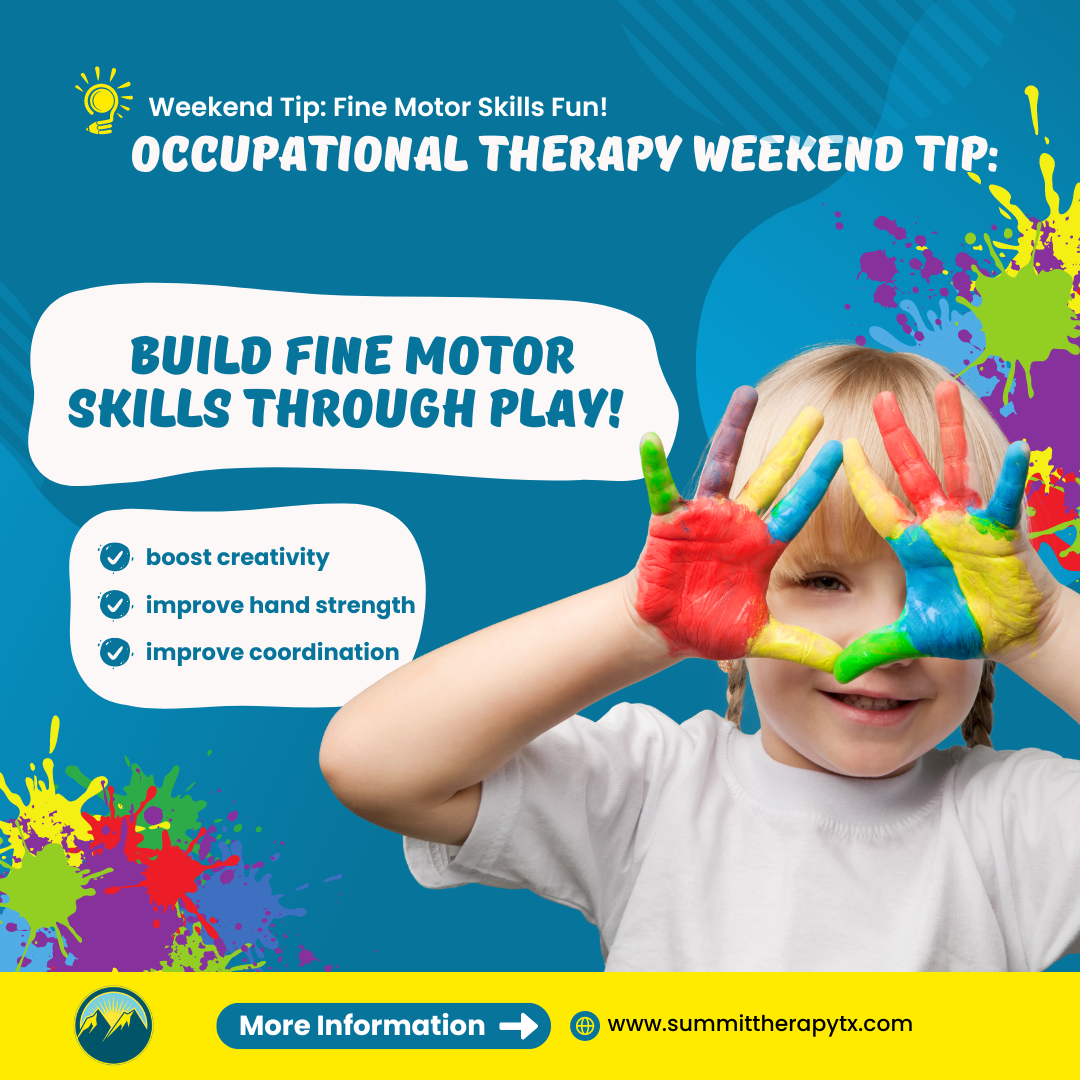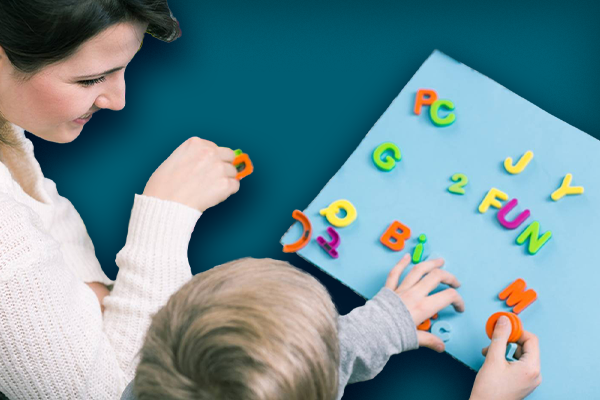Introduction
As parents, we all want the best for our children, especially when it comes to their development.
Motor skills—both fine and gross—play a crucial role in a child’s growth and ability to perform everyday tasks. From writing and buttoning clothes to running and jumping, these skills are fundamental to a child’s success in school and beyond.
At Summit Therapy, we understand the importance of motor skills development, which is why we offer specialized occupational therapy services tailored to each child’s unique needs. But therapy doesn’t stop in the clinic; it’s essential to continue developing these skills at home.
Weekends offer a fantastic opportunity for parents to engage in activities that are not only fun but also therapeutic.
In this guide, we’ll explore 15 weekend activities that parents in Frisco, Plano, and the greater Dallas-Fort Worth (DFW) area can do with their children to boost fine and gross motor skills.
These activities are designed to be simple, enjoyable, and most importantly, beneficial for your child’s development.
Fine Motor Skills Activities
-
Crafting with Paper and Scissors
Benefits: Crafting is an excellent way to enhance hand strength, coordination, and dexterity. Using scissors to cut shapes out of paper helps develop the small muscles in the hands and improves bilateral coordination, which is the ability to use both hands together.
Instructions:
- Set up a craft station at home with child-friendly scissors, colored paper, glue, and markers.
- Encourage your child to create different shapes, animals, or even a collage.
- For younger children, you can draw lines or shapes on the paper for them to cut along, making the task more manageable.
Variations:- For older children, challenge them to create more intricate designs or 3D models using paper.
- Incorporate themes they’re interested in, like creating their favorite animals or characters, to make the activity more engaging. Crafting not only improves fine motor skills but also fosters creativity and problem-solving. Plus, it’s a great way to spend quality time together as a family.
-
Bead Stringing and Lacing
Benefits: Bead stringing and lacing activities are perfect for improving finger precision, hand-eye coordination, and patience. These activities require children to focus on threading beads onto a string or lacing through holes, which strengthens their fine motor control.
Instructions:
- Provide your child with large beads and a sturdy string or shoelace.
- Encourage them to create necklaces, bracelets, or even patterns with the beads.
- For lacing, you can create DIY lacing cards by cutting shapes out of cardboard and punching holes around the edges.
Variations:
- Use different sizes and shapes of beads to increase the challenge as your child’s skills improve.
- Introduce patterns or color sequences for your child to follow, enhancing their cognitive skills alongside their motor development. Bead stringing and lacing are calming activities that can also be a great way to work on concentration and patience, making them ideal for a relaxing weekend afternoon.
-
Playdough and Clay Play
Benefits: Playdough and clay activities are fantastic for strengthening hand muscles, improving dexterity, and encouraging creative expression. These materials are versatile and can be shaped, rolled, and manipulated in countless ways.
Instructions:
- Set up a play area with playdough or clay and a few simple tools like rolling pins, cookie cutters, and plastic knives.
- Encourage your child to create different shapes, animals, or even sculptures.
- Ask them to roll the dough into small balls, flatten it with their hands, or create snakes by rolling it out.
Variations:
- For an added sensory experience, try making homemade playdough with your child, allowing them to measure and mix the ingredients.
- Introduce a theme, such as making a playdough garden or a bakery, to inspire imaginative play. Playdough and clay play are not only fun but also provide a great workout for the small muscles in the hands, preparing them for tasks like writing and buttoning.
-
Buttoning and Zipping Practice
Benefits: Buttoning and zipping are essential self-care skills that also help develop fine motor control and coordination. Practicing these tasks in a playful way can make them less frustrating and more enjoyable for children.
Instructions:
- Use clothing or a DIY button board for your child to practice buttoning and unbuttoning.
- Create a zipper board by attaching zippers of different sizes and lengths to a piece of fabric or cardboard.
Variations:
- Turn it into a game by timing how quickly your child can button or zip up an item.
- Encourage your child to help with dressing dolls or stuffed animals, which adds a fun element to the practice. These everyday tasks are important for fostering independence, and practicing them regularly will make your child more confident in their abilities.
-
Puzzle Time
Benefits: Puzzles are excellent for developing problem-solving skills, hand-eye coordination, and fine motor abilities. They require children to manipulate small pieces and fit them into the correct spaces, which also enhances spatial awareness.
Instructions:
- Start with simple puzzles with larger pieces for younger children.
- Gradually introduce more complex puzzles with smaller pieces as their skills improve.
Variations:- Create DIY puzzles by cutting pictures from magazines or drawings into pieces and having your child put them back together.
- Introduce 3D puzzles or building sets like Lego for an added challenge. Puzzles are not only fun but also provide a quiet, focused activity that children can enjoy on their own or with family members.
Gross Motor Skills Activities
Gross motor skills involve the use of larger muscles in the arms, legs, and torso. These skills are important for activities like walking, running, and jumping. Here are some activities to help improve gross motor skills. -
Obstacle Course
Benefits: An obstacle course is a fantastic way to promote coordination, balance, strength, and endurance. It also encourages children to think critically as they navigate the course.
Instructions:- Set up an indoor or outdoor obstacle course using household items like chairs, pillows, and ropes.
- Include activities like crawling under tables, jumping over obstacles, balancing on a line, and running around cones.
- Time your child as they complete the course and encourage them to beat their own record.
Variations:- Create themed obstacle courses, such as a “pirate adventure” or “jungle exploration,” to make the activity more engaging.
- For older children, increase the difficulty by adding challenges like hopping on one foot or balancing a ball on a spoon while navigating the course. Obstacle courses are a great way to get your child moving, burning off energy while building essential gross motor skills.
-
Balloon Games
Benefits: Balloon games are fun and effective for improving hand-eye coordination, balance, and reflexes. The light weight of the balloon makes it a safe option for indoor play.
Instructions:- Start with simple games like “keep the balloon in the air” by tapping it upwards with hands or feet.
- Play balloon volleyball by setting up a makeshift net with a piece of string and hitting the balloon back and forth.
Variations:- For an added challenge, introduce rules like only using certain body parts (e.g., head, knees) to keep the balloon in the air.
- Incorporate targets, such as hitting the balloon into a specific area or bucket, to work on aim and precision. Balloon games are versatile and can be easily adapted to suit children of all ages, making them a perfect indoor activity for any weekend.
-
Nature Walk and Scavenger Hunt
Benefits: Walking and exploring nature helps children improve their gross motor skills, such as balance, coordination, and endurance. Adding a scavenger hunt element enhances their observational skills and makes the activity more engaging.
Instructions:- Take your child on a nature walk in a nearby park or even your backyard.
- Create a scavenger hunt list of items to find, such as leaves, rocks, or insects.
- Encourage your child to walk, run, jump, and climb as they search for items on the list.
Variations:- Make it a themed scavenger hunt based on the season (e.g., finding fall leaves or spring flowers).
- Incorporate sensory elements by asking your child to describe the textures or sounds they encounter during the walk. Nature walks and scavenger hunts are not only great for physical activity but also provide an opportunity to connect with the natural world and learn about the environment.
-
Playground Time
Benefits: Playgrounds are full of equipment that promotes gross motor skills, including climbing, swinging, and sliding. These activities help children develop strength, coordination, and confidence in their physical abilities.
Instructions:- Visit a local playground and encourage your child to explore all the equipment.
- Focus on activities that challenge their motor skills, such as climbing ladders, swinging on monkey bars, or balancing on beams.
Variations:- Create challenges or goals, such as how many times they can swing back and forth or how fast they can climb to the top of the slide.
- Join in the fun by playing tag or a game of follow-the-leader on the playground. Playgrounds offer a dynamic environment for motor skills development, and the variety of equipment ensures that there’s always something new to explore.
-
Dance Party
Benefits: Dancing is an excellent way to improve balance, rhythm, and coordination while also being a fun and energetic activity. It allows children to express themselves creatively and burn off energy.
Instructions:- Set up a dance party at home with your child’s favorite music.
- Encourage them to dance freely, or introduce simple dance moves that challenge their coordination and timing.
Variations:- Teach your child a specific dance routine or create one together.
- Incorporate props like scarves or ribbons to add an element of fun and improve hand coordination. Dancing is a joyful activity that can be enjoyed by the whole family, making it a perfect way to bond and stay active during the weekend.
Sensory Motor Skills Activities
Sensory motor skills involve the integration of sensory input (like touch, sight, and sound) with motor responses. These activities help children develop body awareness and improve their ability to respond to sensory stimuli. -
Sensory Bins
Benefits: Sensory bins are containers filled with various materials that encourage exploration and play. They are excellent for developing both fine and gross motor skills, as well as sensory processing abilities.
Instructions:- Create a sensory bin by filling a large container with materials like rice, sand, beans, or water beads.
- Add objects such as small toys, spoons, and cups for your child to scoop, pour, and manipulate.
Variations:- Theme your sensory bins based on seasons or holidays, such as using fall leaves and acorns in the autumn.
- For an added challenge, hide small objects in the sensory bin and have your child find them using only their hands. Sensory bins provide a calming, focused activity that helps children engage their senses while working on motor skills.
-
Water Play
Benefits: Water play is a versatile activity that supports hand-eye coordination, muscle strength, and sensory processing. It can be easily set up at home and offers endless possibilities for exploration.
Instructions:- Set up a water table or a shallow container filled with water.
- Provide toys like cups, funnels, and sponges for your child to use.
Variations:- Add food coloring or bubbles to the water for a sensory twist.
- Create a “water wall” using a piece of vertical surface (like a fence or wall) with attached containers and tubes for pouring water. Water play is not only refreshing on a hot day but also helps children develop motor skills while engaging their senses in a fun way.
-
Cooking Together
Benefits: Cooking is a practical activity that involves various motor skills, including fine motor (stirring, kneading) and gross motor (reaching, lifting). It also teaches children valuable life skills and encourages them to try new foods.
Instructions:- Choose a simple recipe that involves tasks your child can safely help with, such as stirring, mixing, or kneading dough.
- Allow your child to measure ingredients, pour them into bowls, and mix them together.
Variations:- For younger children, focus on tasks that don’t involve sharp tools or hot surfaces, like washing vegetables or mixing batter.
- Turn it into a sensory experience by encouraging your child to smell, touch, and taste theningredients as you cook. Cooking together is not only a fun and educational weekend activity but also a way to instill healthy eating habits and a love for homemade meals.
-
Building with Blocks
Benefits: Building with blocks, such as Legos or wooden blocks, enhances spatial awareness, hand-eye coordination, and fine motor skills. It also encourages problem-solving and creativity.
Instructions:- Provide your child with a variety of blocks and encourage them to build structures, towers, or even entire cities.
- Set challenges, such as building the tallest tower or creating a specific shape.
Variations:- Introduce themes, such as building a castle or a zoo, to make the activity more engaging.
- Use larger blocks for younger children and more complex building sets for older ones. Block play is a timeless activity that allows children to explore their creativity while working on essential motor skills.
-
Yoga for Kids
Benefits: Yoga is a wonderful way to improve balance, flexibility, and body awareness. It also promotes mindfulness and relaxation, making it a great weekend activity for children of all ages.
Instructions:- Introduce your child to simple yoga poses, such as tree pose, downward dog, and cat-cow.
- Use a yoga mat or a soft surface to practice the poses.
Variations:- Make it fun by turning the poses into a story or an adventure, such as pretending to be animals in the jungle.
- Practice yoga together as a family to encourage bonding and relaxation. Yoga is not only beneficial for physical development but also helps children learn to focus, relax, and connect with their bodies.
Conclusion
Weekends are the perfect time to engage in activities that not only entertain but also support your child’s development. By incorporating these motor skill-building activities into your weekend routine, you can help your child improve their fine and gross motor abilities in a fun and relaxed environment.
At Summit Therapy, we’re dedicated to supporting parents in Frisco, Plano, and the greater DFW area with expert occupational therapy services tailored to each child’s unique needs. These activities are just a starting point—our therapists can provide even more personalized recommendations based on your child’s specific goals.
If you’re looking for professional guidance in helping your child develop essential motor skills, don’t hesitate to reach out to us at Summit Therapy. Our experienced therapists are here to help your child thrive. Contact us today to schedule a consultation or learn more about our comprehensive therapy services.
Call-to-Action
Ready to support your child’s development with expert guidance? Visit Summit Therapy TX to learn more about our occupational and speech therapy services. Don’t forget to share this blog with other parents in Frisco, Plano, and the DFW area to spread the word about these fun, developmentally beneficial activities!





